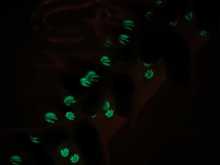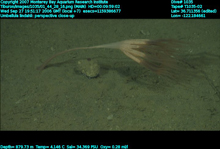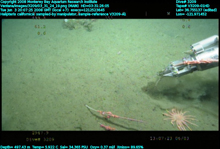Bioluminescence
Steven Haddock, PhD
Research Scientist
Monterey Bay Aquarium Research Institute
Bioluminescence is one of the ocean's most amazing natural phenomena. It seems to be drawn from science fiction or comic books, rather than science and natural history. Where else do you find characters adorned with green lanterns, or shooting beams of red light, or escaping in a flash of blue? How can a living animal make light? The technical answer is that light is produced by energy released from chemical reactions either occurring inside or ejected by an organism.
One would think that this capability would be rare in nature, yet in the ocean most types of animals — ranging from bacteria to sharks — include bioluminescent members. In fact, it is estimated that luminescence has evolved independently at least 40 times. The functions of bioluminescence are not known for all animals, but typically it is used during ecological interactions for defense (warning or evading predators) or offense (luring or detecting prey), and at times for communication between members of the same species.
In addition to spanning the range of marine diversity, bioluminescence is also found throughout the spectrum of marine habitats, from the surface to the deep-sea floor. Despite its common presence, bioluminescent remains difficult to study. This reason is that organisms must be captured in good condition to witness their bioluminescent behavior. Nets and grab-type samplers are too indiscriminate to obtain healthy specimens from the deep ocean floor a kilometer (about 3/5 mile) below the surface. As a result, the properties and extent of bioluminescence in deep-sea corals and associated deep-reef communities is very poorly known.
The optical "cousin" of bioluminescence is the phenomenon of fluorescence. In fluorescent compounds, energy from one color (or wavelength) of light is converted to another color. Fluorescence is often associated with bioluminescence because (1) bioluminescent chemicals can sometimes fluoresce, and (2) fluorescent proteins can be chemically linked to the light-emitting bioluminescent chemicals. Why is fluorescence important? It’s important because it gives organisms living in a monochromatic environment (the blue light from the surface, or bioluminescence itself) a way to appear colorful and to tailor their visual signals.
























